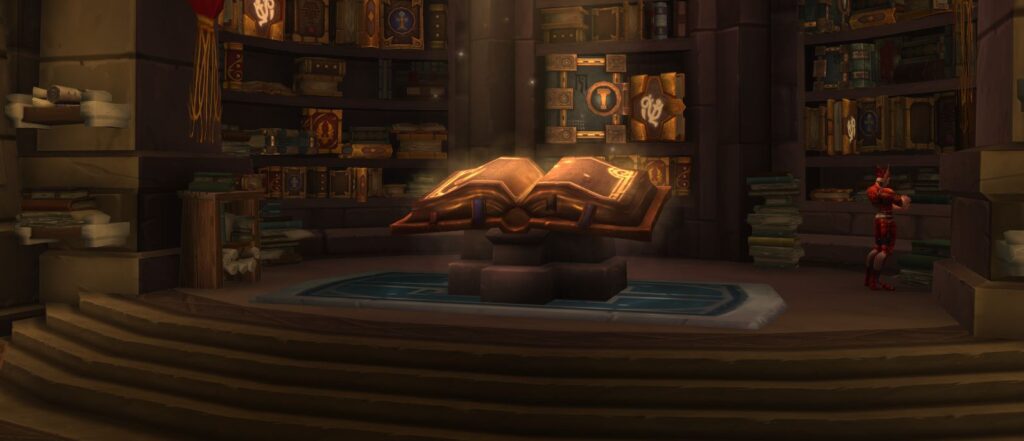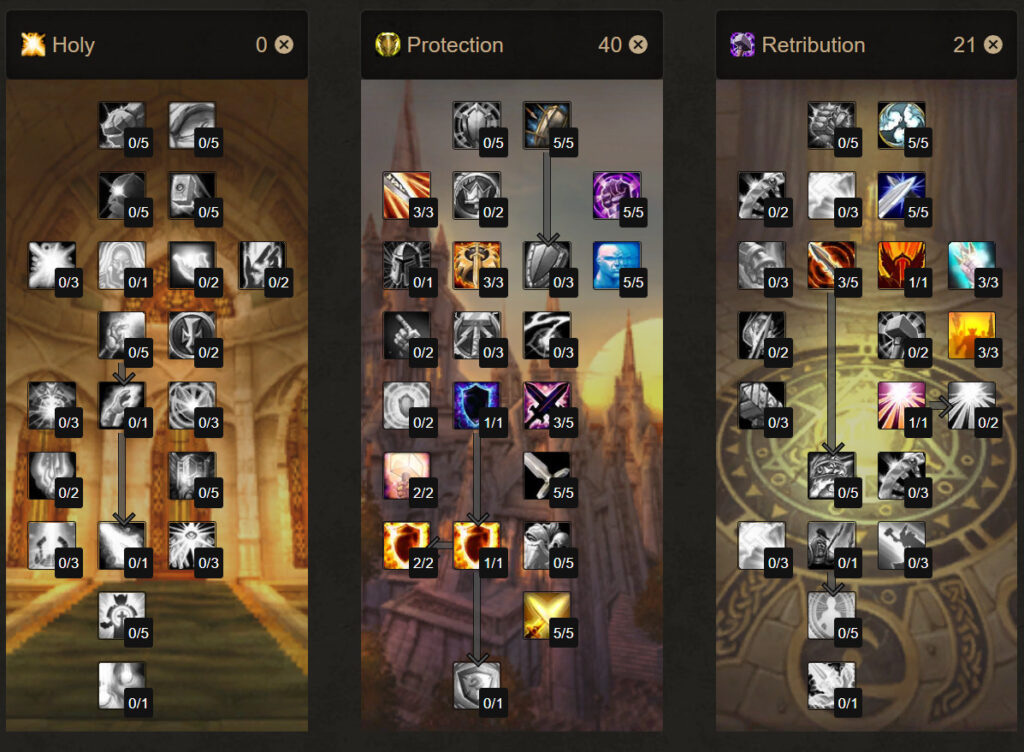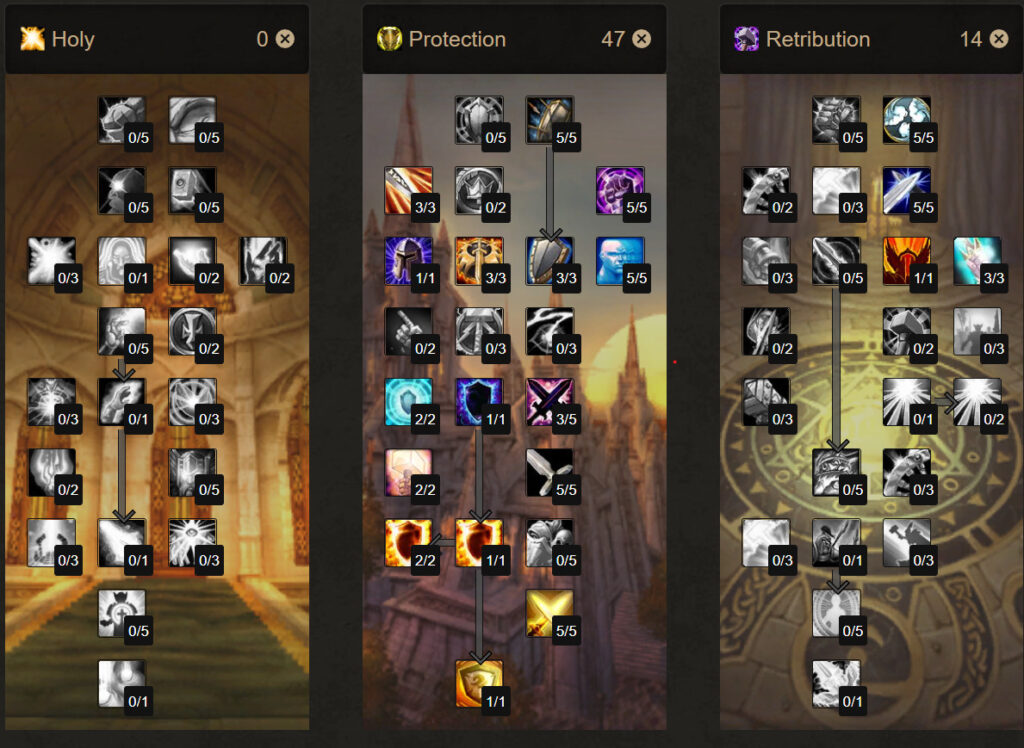- Author: Pride
- Date: December 3, 2021
- Updated: February 16, 2022
- Expansion: TBC Classic
There are generally 2 talent builds that Protection Paladins will be using throughout every phase of The Burning Crusade:
- The Sanctity Aura build, the more popular of the two, generally best for raiding and solo play
- The Avenger’s Shield build, generally not as popular anymore, but useful in 5-man normal & heroic dungeons
The two builds have very small differences so the choice between the 2 isn’t extremely consequential for the most part. If you are tanking raids in a guild where DPS players deal a lot of threat however, the Sanctity Aura build is definitely recommended as it provides superior threat which you may very well need.
Sanctity Aura Build
Sanctity Aura is the key point of this build. It’s a very straightforward aura, increasing your Holy damage done by 10% while it is active. Depending on the encounter, your equipment and your playstyle, 80 to 95% of your damage will be Holy. That means that Sanctity Aura will increase your damage, and consequently your threat, by 8 to 9.5%, which is very significant.
This will not translate into a straight-up 8 to 9.5% threat increase over a non-Sanctity Aura build, as you lose access to Retribution Aura, so the threat increase is very slightly smaller in practice. Sanctity Aura scales significantly better however, so the gap between the two will just keep getting bigger and bigger as your gear improves.
It is important to note that Sanctity Aura does not stack, so if you find yourself being grouped up with a Retribution Paladin frequently, then there is generally no point in using this build. However, this scenario will be extremely uncommon, as generally it is sub-optimal for a protection paladin to be in a melee group.
It should be said that if your guild’s DPS is not particularly high, meaning the extra threat output isn’t needed as your DPS players do not get held back by threat, then this build might not be a good choice for you. You could instead opt for the Avenger’s Shield build, giving you access to more defensive talents instead.
This build is generally the best build for tanking in raids, as it helps push your threat ceiling to its limit. It is also extremely good if you find yourself off-tanking a lot. When you’re not tanking, the 10% Holy damage increase will help push your DPS a small bit which is definitely appreciated. It’s also decent in solo content, where the additional Holy damage can help you kill things faster, making AoE farms more efficient.
Where this build struggles is with 5-man dungeon content. You will typically not have a Hunter for Misdirection, so unless you are an engineer, you will not have access to a ranged spell to make pulling easier, without utilizing clever tricks like Explosive Rocket. You can always have someone else pull for you, but losing Avenger’s Shield is definitely a detriment there.
Avenger’s Shield Build – Deep Protection
Avenger’s Shield is the key point of this build. It’s an active ability with a 1 second cast and a 30 second cooldown, that deals Holy damage and dazes your target and up to 2 other enemies near it. Besides looking extremely cool, Avenger’s Shield is amazing for pulling, as protection paladins do not have access to any other long range abilities.
It deals a decent amount of Holy damage, which then gets multiplied by Improved Righteous Fury to a very decent threat amount, giving you a solid thread start and allowing your DPS players to start dealing damage earlier than with other builds.
It’s not sunshine and rainbows for it however. Your character is unable to block, dodge or parry while casting, and there’s no spell pushback protection for Avenger’s Shield, making it extremely annoying & risky to use while actively tanking. This is particularly true in raids, where you may just get a crushing blow and die while casting it.
Furthermore, it costs a fairly high amount of mana – 780 for rank 3, to be precise. This means that even in dungeons, where it’s strongest, it will end up steadily draining your mana pool until you are forced to drink, slowing you down. Using it while questing or farming is also a very bad idea, for the same reason.
Thus Avenger’s Shield will almost always be an ability you only use once, for pulling at the start of the fight. There may be situations on specific bosses where you can sneakily cast it again, but do not attempt to do so while the boss is attacking you.
Other Options
Many new protection paladins will look at this talent and wonder why most recommended builds do not include it. This is understandable, as the ability looks very good on paper, but suffers from a major flaw that players have named leap-frogging.
In simple terms, leap-frogging refers to getting hit by an ability and dying in one hit, without Ardent Defender even activating. For instance, if you’re at 36% HP and the boss attacks you with an ability that does 40% of your HP worth of damage, Ardent Defender will not save you — you will just die, essentially having spent 5 points on a talent that did nothing.
That doesn’t mean the talent is bad in general. It can be very useful in 5-man dungeons and solo content, where you’re very unlikely to die to leap-frogging. It’s by no means completely useless in raids either, it just won’t save your life as often as you imagine it might.
The Avenger’s Shield build could spare 5 points for it, though the Sanctity Aura generally doesn’t have that luxury.
This is another instance of a talent that sounds really good on paper but falls slightly short.
Attacking extra times definitely feels cool, but this talent only boosts your melee & Seal of Righteousness damage, which will typically make up about 25-35% of your damage. That is not bad by any means, but there’s generally better places to put your talent points.
Spending 5 talent points on it will usually be too much, but a lot of players will put their left-over talent points into Reckoning, typically ranging between 1 to 3 points.
Another talent that looks stronger on paper than it actually is.
Your block value will typically be very low compared to the amount of damage bosses deal, making a 30% boost to it mostly imperceivable. However, it is an okay amount if you’re tanking trash, and even more so in 5-man dungeons, when you’re farming gold, etc.
For that reason it’s not a terrible talent per se, but you typically only take it after you’ve picked up more important talents. More commonly, you just put your remaining points into it, where it’s basically a toss-up with Reckoning.
This talent is pretty good. However, protection paladins aren’t the best at tanking caster-type mobs and bosses. For that reason, your guild may choose to have a Protection Warrior or Feral Druid tank such bosses instead, meaning this talent won’t get as much use.
Similarly to other talents, you take this after you’ve taken all of the important talents, and cutting it is okay.
Blessing of Kings is an incredibly powerful talent, increasing the target’s stats (strength, agility, intellect, stamina) by 10%. No raid should ever go without it, and it helps 5-man groups a lot too.
However, your raid’s Retribution Paladin will typically pick up this talent as there’s generally no other useful talents for them to take. So if you’re running the Sanctity Aura build, which is very tight on talent points, it’s usually fine to drop this talent, provided you’ve communicated with your other paladins about it.
This talent is almost completely worthless for tanking, as Seal of Righteousness and Seal of Vengeance will handily outperform it, provided you’re using proper tank gear.
However, it enables you to switch to a two-handed weapon and DPS gear on fights where you’re not tanking and use a paladin trick called Seal Twisting along with Seal of Blood, and deal significantly more damage than you would have with your standard setup of spell power gear with a one-handed weapon and shield along with Seal of Righteousness.
In combination with Sanctity Aura, you can actually do a surprisingly decent amount of damage overall, helping your guild kill a boss a little bit faster.
So if you find yourself not needing to tank frequently, it is definitely worth it to pick up Seal of Command for just 1 talent point, provided you have a two-handed weapon to go along with it, at the very least.
This talent is also not straight up bad, but it’s also stronger on paper than what it actually is.
Simply put, having Judgement on an 8 second cooldown will occasionally cause it to overlap with your Holy Shield cooldown. As you never want to delay your Holy Shield, as you would be risking taking a crushing blow, that means you’ll choose to delay the Judgement instead, meaning this talent did nothing.
For that reason, it’s usually best to just skip this talent and leave Judgement on a 10 second cooldown, which is the same as Holy Shield‘s cooldown, causing them to never overlap & always be in sync.
After picking up the obviously useful Retribution talents, it’ll be very common that you don’t know which talents to take to keep moving deeper into the tree, typically for Sanctity Aura.
Here are your options, explained:
By far the strongest of all your options. 1% crit chance per talent point matches Conviction point for point, while also increasing your spell critical strike chance, handy for your Judgement of Righteousness.
However, in most 25-man raids, you’ll typically have a Retribution Paladin running this talent. You can only have 1 instance of the Judgement of the Crusader debuff up at a time, meaning only one of you needs to run this talent.
Having your Retribution Paladin use it is better for your raid overall, as it allows you to start off with Judgement of Righteousness instead for maximum threat. Thus you really shouldn’t have to take this talent.
This talent is arguably the second most useful of all your choices, but that’s not saying much because it’s just not that good overall.
It gives 1% melee critical strike chance per point, which only applies to your auto attacks. As they’re a very small percentage of your overall damage, and their threat does not get amplified by Righteous Fury, this results in a very small threat increase.
It’s the best choice if you’re main tanking bosses provided you don’t need to run Improved Seal of the Crusader, which as previously mentioned, you really shouldn’t have to.
This talent becomes significantly better however if you’re running Seal of Command along with a two-handed weapon when you’re not tanking, as mentioned in the Seal of Command section of this guide. It boosts most of your attacks in that case, making it pretty good.
This talent is pretty weak, as it does not work on raid bosses. However, it does work on trash, reducing their health, damage done, armor and dodge chance very slightly.
If you don’t plan on using a two-handed weapon ever, making Seal of Command not really an option, then you could take this talent instead of Conviction, which would help your raid with trash slightly.
A 50% boost to one of your most frequently used auras sounds pretty good, and indeed it is.
The problem with this talent is that it’s just too deep in the Retribution tree. Realistically speaking, if you’re only this deep in Retribution it’s because you’re going for the Sanctity Aura build, so you’d have no reason to use Retribution Aura anymore, making this talent useless.
Spells cast by monsters cannot be critical strikes, meaning this talent will never activate in PvE content. There’s one exception: having any amount of Resilience on your gear will give you a chance to proc Eye for an Eye on non-critical hits at a rate equal to your Resilience % (so if you have 5% crit chance reduction through resilience, you have a 5% chance to proc Eye for an Eye).
This doesn’t make it all that much more appealing, specially since Resilience is almost exclusively found on PvP gear, which doesn’t have the best tanking stats usually.
It’s not particularly strong in PvP either, so there’s basically no reason to ever take this talent.
About the Author





Good to see a guide with up to date and accurate information. Thanks Pride.
The information you posted about Improved Judgement is not quite correct. Specifically, contrary to what you said, Judgement does NOT share the GCD with other spells. So you CAN overlap Judgement with Holy Shield. However, there will be up to 1.5 seconds delay when re-casting your preferred Seal after Holy Shield.
Hi, thanks for your comment. The guide does not say that Judgement is on the GCD — as a long-time paladin main I would be well aware of that! The second part of your post, delaying the re-Seal process by 1.5 seconds, is what I was referring to. If you don’t delay your Judgement, you will instead do a “naked” swing with no Seal on, potentially twice due to Reckoning, which means you lose holy damage / threat from that seal proc.
That trade-off is what I was referring to — I used simple language to convey that concept as simply as possible to newer players. If I were to use more words, I’d say Improved Judgement is not a raw threat increase with no drawbacks. You deal 20% more Judgement damage / threat, but you also deal less seal damage / threat in exchange, making it a pretty poor threat per talent point investment, hence many top paladins do not take it and just stick to having a constant rotation with Holy Shield and Judgement having the same cooldown. Hope that clarifies 🙂
Improved Judgement is handy in situations where you are the OT, and you find yourself “chasing” a warrior/druid MT (when you don’t need to use holy shield). Also while tanking mobs that cannot be blocked (e.g. Hydross, Flame of Azzinoth). Another situational benefit is that the 2 seconds you save can be vital for snap-threat on a target.
It’s really a toss-up between the above, or putting the talent points in seal of command/conviction and using a two-hander. Not saying you’re wrong.
Cheers.
Very good points! Like the other talents I mention, Improved Judgement certainly has its uses and there’s niche situations where it can be great even. However my general point in its section is that when you see the talent, you kinda go “whoa, 20% more Judgements? that’s amazing!” but it’s sadly not that simple, it’s not as straight-forwardly good as the other talents I don’t mention in the “Other Options” section.